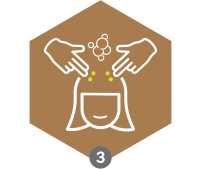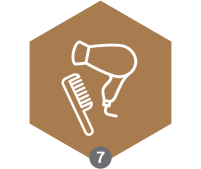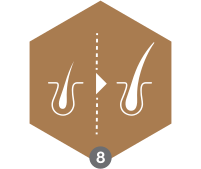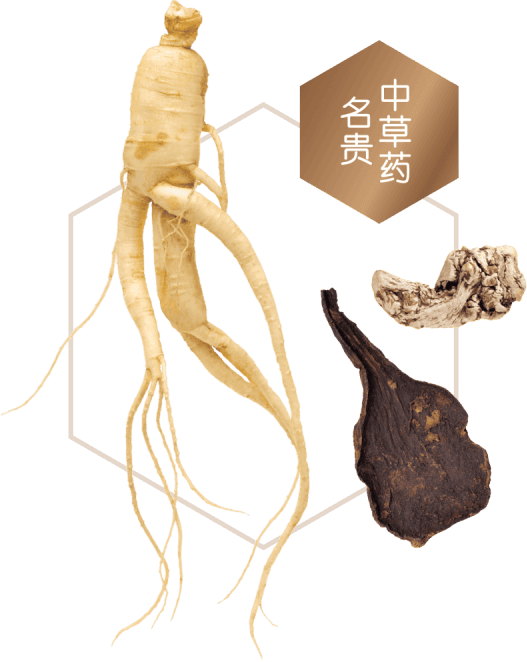Hair loss treatment includes solutions designed to address hair thinning, baldness, and other scalp issues. These methods promote hair development, improve hair and scalp health, and restore confidence in those suffering from hair loss.
Factors such as heredity, hormonal changes, medical disorders, stress, and the environment can cause hair loss, which may present as thinning hair, a receding hairline, or bald patches. Hair loss therapies aim to stimulate hair growth, reinforce existing hair follicles, enhance scalp health, and address underlying reasons for hair loss.
Various types of hair loss treatments are available in the market, ranging from topical solutions and medications to non-invasive procedures and surgical options. Topical treatments like shampoos, serums, and lotions promote hair regrowth and prevent further hair loss.
Non-invasive treatments include low-level laser therapy, scalp massages, and microneedling, which increase blood circulation, enhance nutrient delivery to hair follicles, and promote hair growth.
Traditional Chinese Medicine (TCM) treatments involve practitioners assessing the body's Qi (energy flow) to identify imbalances that cause hair loss. Herbal remedies, acupuncture, scalp massages, and dietary changes are all important components of TCM hair loss therapies.
Individuals experiencing hair loss should visit a hair loss professional for a full diagnosis and personalised treatment recommendations. A comprehensive approach that incorporates lifestyle modifications, proper hair care practices, and specialised therapies can help people manage hair loss and keep their hair and scalp healthy.
Discover why choosing Beijing 101 as your ideal hair loss partner is the right decision. Benefit from our in-house expertise and commitment to excellence, ensuring an effective and personalised hair loss treatment in Singapore.
In-House TCM Physicians
Beijing 101's distinct advantage of having in-house TCM physicians makes us stand out as a top option for male and female hair loss treatment in Singapore. We have a team of committed TCM specialists who specialise in hair and scalp health providing customised consultations and treatments tailored to your unique hair loss conditions.
The core tenets of TCM are based on centuries-old holistic healing techniques that emphasise reestablishing harmony and balance in the body. To promote long-term hair and scalp health, this holistic approach not only addresses the symptoms of hair loss but also the underlying causes; by combining the knowledge of TCM with contemporary hair and scalp care techniques.
Best Service
At Beijing 101, we take pride in offering you the best results and service in the hair loss treatment industry. Our success stories speak volumes about our effective solutions and the level of care we provide. We understand that hair loss can impact your confidence and well-being, which is why we prioritise giving you personalised attention and care.
From your initial consultation to the treatment sessions, our team ensures that you receive the best possible care. We take the time to study your individual hair and scalp condition, lifestyle factors, and concerns to come up with a treatment plan that is personalised to your needs.
Trust Beijing 101 to be your partner in regaining healthy hair and scalp, and renewed confidence. Experience the difference of personalised care, proven results, and exceptional service with Beijing 101.
Beijing 101's hair loss treatments offer several advantages.
Comprehensive Diagnosis and Treatment Plans
At Beijing 101, our approach to hair loss treatment begins with a thorough diagnosis. We believe in identifying the underlying causes of each individual's hair loss. Our consultants perform evaluations, taking into account your unique hair and scalp condition. This enables us to develop personalised treatment regimens that target the underlying causes of hair loss, resulting in more effective and long-lasting outcomes.
Our treatment plans are not one-size-fits-all. We understand that each person's hair and scalp are unique and require specialised remedies. Our solutions cater to your specific needs, be it male pattern baldness, female hair thinning, or scalp concerns. This personalised approach ensures that you receive focused interventions that boost hair growth, scalp health, and overall hair quality.
Natural and High-Quality Ingredients
Another important factor that distinguishes Beijing 101's hair loss remedies is our commitment to employing natural, high-quality products. We recognise the value of safety, efficacy, and sustainability in hair care products and treatments. Therefore, we incorporate high-quality herbs, botanical extracts, and other natural components proven to enhance hair and scalp health. We use premium-grade Chinese herbs such as Dang Gui, He Shou Wu, Ginseng.
Our products and treatments are devoid of harsh chemicals and artificial additives, which can harm hair and scalp health over time. Instead, we use the power of nature to nourish, strengthen, and revitalise your hair follicles and scalp. Using delicate yet effective ingredients, we ensure that our treatments not only address hair loss but also promote overall hair vitality and resilience.
Ongoing Support and Education
At Beijing 101, we believe that successful hair loss treatment extends beyond the outlet. We offer ongoing support and education to help throughout your hair care journey. Our team of professionals provides advice on optimal hair care techniques, lifestyle changes, and maintenance routines to complement our treatments.
In addition, we value transparency and open communication. We make sure to walk you through the treatment procedure, expected outcomes, and any potential concerns. This transparent approach develops trust and collaboration, resulting in a more positive and satisfying experience throughout the hair loss treatment process.



























